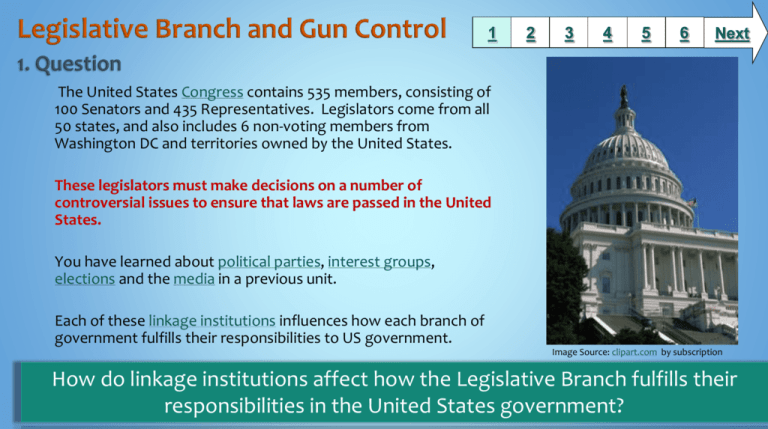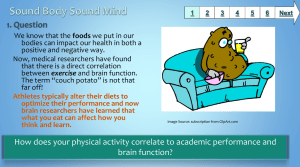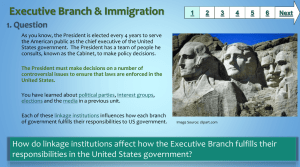
1
2
3
4
5
6
Next
The United States Congress contains 535 members, consisting of
100 Senators and 435 Representatives. Legislators come from all
50 states, and also includes 6 non-voting members from
Washington DC and territories owned by the United States.
These legislators must make decisions on a number of
controversial issues to ensure that laws are passed in the United
States.
You have learned about political parties, interest groups,
elections and the media in a previous unit.
Each of these linkage institutions influences how each branch of
government fulfills their responsibilities to US government.
Image Source: clipart.com by subscription
How do linkage institutions affect how the Legislative Branch fulfills their
responsibilities in the United States government?
1
2
3
4
5
Each of the linkage institutions can influence Congress in a number of ways.
By researching the topic of Gun Control, you can investigate how each
linkage institution has influenced Congress.
Political Parties
Elections
Beliefs of the GOP
Giffords’ Gun Control PAC to test her political
appeal
2012 Republican Platform
National Association for Gun Rights
DNC Platform (click ‘Issues’ tab)
On the Issues – Republican Party
On the Issues – Democratic Party
Interest Groups
Media
NBC Learn - NRA & Legislators
Gun Control and the Media
NBC Learn – NRA “Guns in Schools” Ad
10 Social Media Moments that Shaped the Gun
Control Debate
Federal Legislation Updates – NRA
National Guns Special Interest Groups
How Media Loses Interest in Gun Control
Image Source: clipart.com by subscription
6
Next
1
2
3
4
5
Using the resources on the
previous slide, create your own
notes pages or use the linked page
below to organize your ideas about
how your assigned linkage
institution(s) impact the Legislative
Branch:
Notes
Image Source: clipart.com by subscription
6
Next
1
Use your notes to create an Infographic describing how
the linkage institution(s) you researched has influenced
the Legislative Branch in making decisions regarding
Gun Control.
Be sure to include the following in your Infographic:
The name and a description of the linkage institution(s) you
researched
How does that linkage institution impact how the Legislative
branch conducts their business of creating laws?
To create your Infographic you can use one of the following digital
tools:
Piktochart
Microsoft Publisher
2
3
4
5
6
Next
Click on the
Infographic to the left
to see the “Big Guns
of the Gun Debate”.
Use the zoom
feature to view
details of the image.
Image Source: forbes.com and
Appinions
1
The Pew Research center collects data
regarding all types of topics relevant to
American citizens. How do Americans
feel about gun control?
Key Data Points from Pew Research
Gun Control topic from Pew Research
3
4
5
6
Next
Extension: Use these sites to learn more
about YOUR Congress:
2
How can the Legislature increase participation
from its citizens?
Want to check up on your legislator in
Congress?
Do you have an interest in working as an intern
for a Congressman or Senator?
Add the data you’ve analyzed into the
Infographic you created on the previous
page.
Image Source: clipart.com by subscription
1
2
3
4
5
6
BCPS Curriculum
Time Frame: 1 90 minute class period
Unit 4 – Congress Indicator 1: Students will analyze the structures and powers of Congress in order to evaluate its effectiveness as a legislative body.
(IV-AB) Objective 11: Analyze the relationship between Congress and linkage institutions.
Maryland State Curriculum
Differentiation: Each graphic organizer can be
1. The student will demonstrate understanding of the structure and functions of government and politics in the United States
created by the students - does not need to use
B. Individual and Group Participation in the Political System Indicator 1. The student will explain roles and analyze strategies individuals or groups may
the provided resources. Databases have text-touse to initiate change in governmental policy and institutions (1.1.4). b. Analyze the external factors that influence the law-making process including the
speech features for some articles. Teacher can
roles of the media, lobbyists, Political Action Committees (PACs), special-interest groups, citizens and public opinion (Unit 3) d. Evaluate how the media,
political parties, special-interest groups, lobbyists, Political Action Committees (PACs) influence public opinion and government policies e. Evaluate the
choose to divide students in class by linkage
reliability and influence of the media on elections, elected officials and public opinion f. Describe the roles of political parties in the United States and
institution and have students research/take
how they influence elections, elected officials and public opinion g. Describe how citizens, candidates, campaigns and campaign financing influence the
notes/create Infographic on 1 institution.
political process in the United States k. Analyze various methods that individuals or groups may use to influence laws and governmental policies
including petitioning, letter writing and acts of civil disobedience (Unit 7)
Common Core State Standards
CCSS.ELA-Literacy.RH.9-10.1 Cite specific textual evidence to support analysis of primary and secondary sources, attending to such features as the date Learning Styles: Field Dependent, Field Independent,
Visual, Auditory, Tactile, Reflective, Global
and origin of the information.
CCSS.ELA-Literacy.RH.9-10.3 Analyze in detail a series of events described in a text; determine whether earlier events caused later ones or simply
preceded them.
AVID Strategies:
CCSS.ELA-Literacy.RH.9-10.9 Compare and contrast treatments of the same topic in several primary and secondary sources.
CCSS.ELA-Literacy.WHST.9-10.2 Write informative/explanatory texts, including the narration of historical events, scientific procedures/ experiments, or
inquiry based learning, Cornell notes, one pager,
technical processes.
rubric
CCSS.ELA-Literacy.WHST.9-10.6 Use technology, including the Internet, to produce, publish, and update individual or shared writing products, taking
advantage of technology’s capacity to link to other information and to display information flexibly and dynamically.
CCSS.ELA-Literacy.WHST.9-10.7 Conduct short as well as more sustained research projects to answer a question (including a self-generated question) or
solve a problem; narrow or broaden the inquiry when appropriate; synthesize multiple sources on the subject, demonstrating understanding of the
Notes to the teacher:
subject under investigation.
Consult with your School Library Media Specialist
Standards for the 21st Century Learner
1.1.6 Read, view, and listen for information presented in any format (e.g. textual, visual, media, digital) in order to make inferences and gather
to implement this Slam Dunk Lesson.
meaning.
Students can turn in activities by saving Cornell
2.1.3 Use strategies to draw conclusions from information and apply knowledge to curricular areas, real-world situations, and further investigations.
Maryland Technology Literacy Standards for Students
notes/one pager and copying it to your school’s
3.0: Use a variety of technologies for learning and collaboration.
student drive/printing and turning in
Last updated: July 2015
Created by Jamie Higgins Shaull, Department Chair – Social Studies/Library Media Intern
BCPS Slam Dunk Research Model, Copyright 2013, Baltimore County Public Schools, MD, all rights reserved. The models may be used for educational, non-profit school use only.
All other uses, transmissions, and duplications are prohibited unless permission is granted expressly. This lesson is based on Jamie McKenzie’s Slam Dunk Lesson module.











